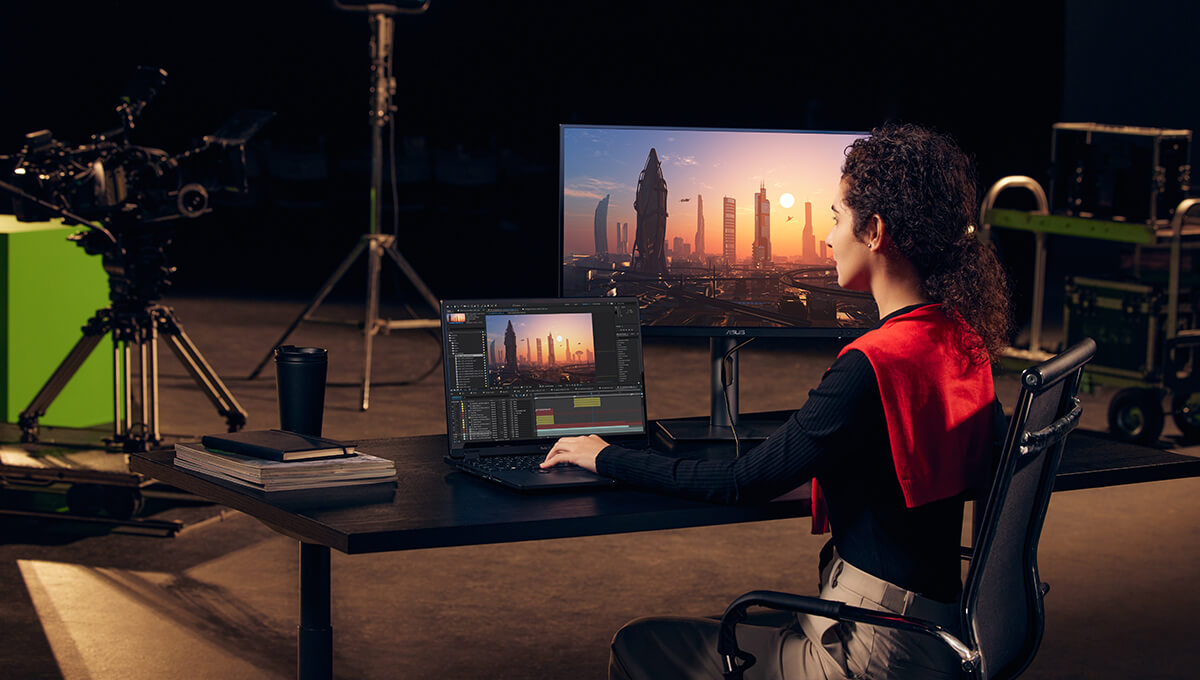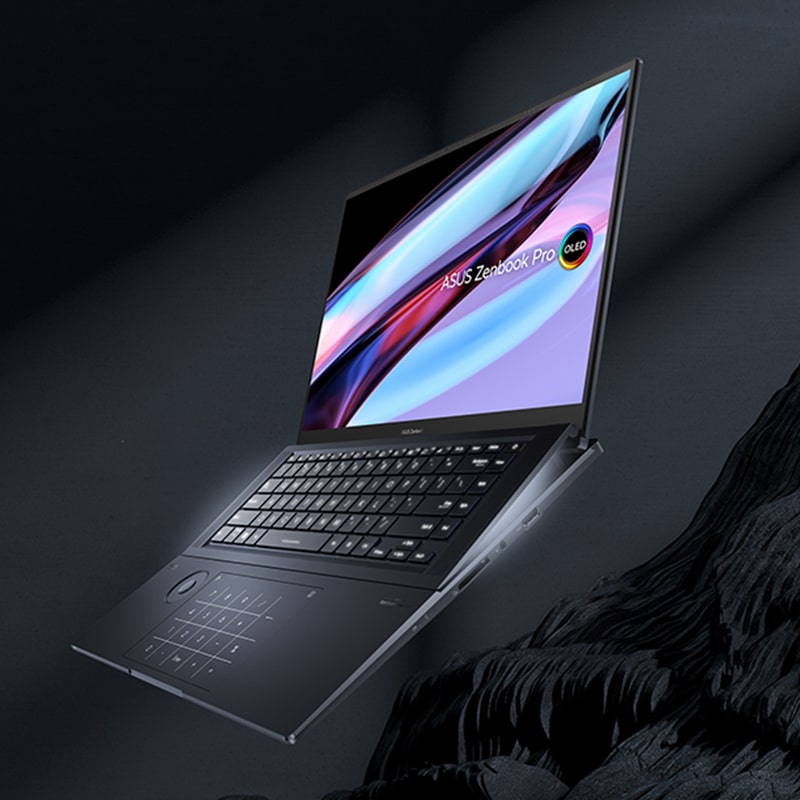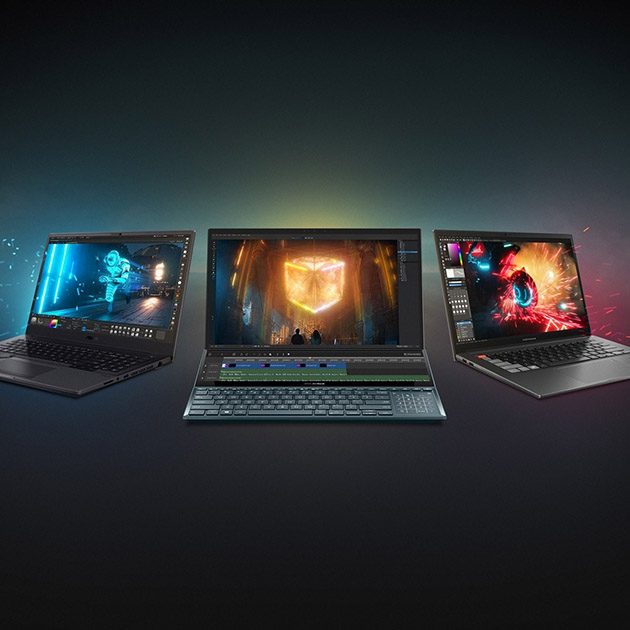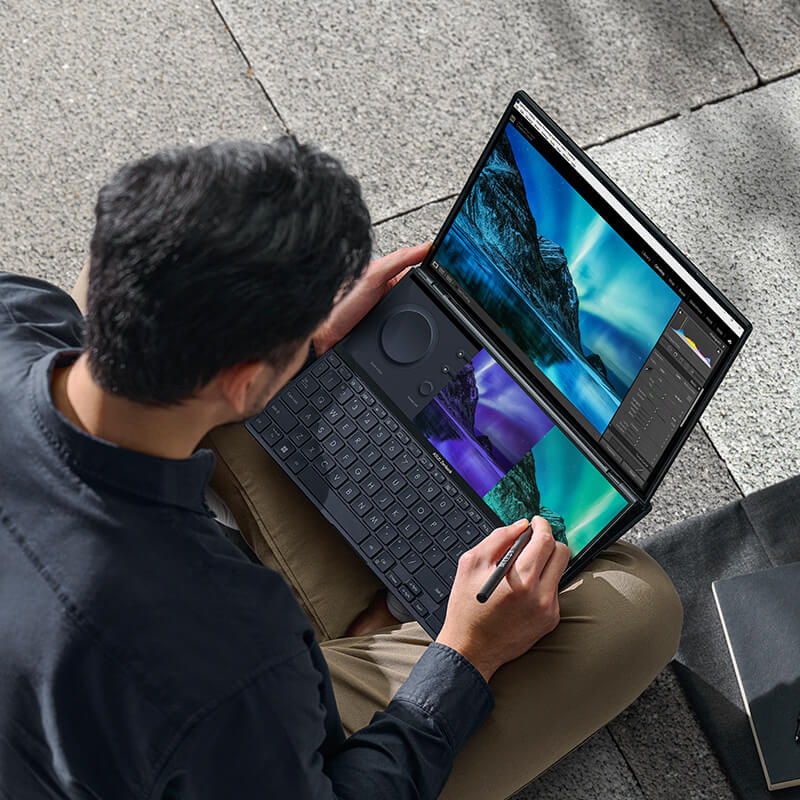
Aug 31, 2023
When it comes to bringing your artistic visions to life, a powerful
creator laptop will be your greatest ally. One key component in such
laptops is the dedicated GPU (dGPU). Choosing the right one for your
type of work can be the difference between creating efficiently and
smoothly and struggling due to insufficient graphical power. But
first, you’ll need to understand what dedicated GPUs are, why you’re
better off with one (instead of only integrated graphics), and what
key specs to pay attention to.
Below, you will find some key facts about dedicated GPUs as well as
recommendations about which laptop GPU is suitable for different
types of creation. Plus, you’ll learn about some of the creator
laptops from ASUS that feature these graphics cards. So, let’s dive
in!
Discrete vs. Integrated GPU
What’s the difference between an integrated GPU and a dedicated GPU?
The former is built into the CPU, sharing its power; a dedicated
(aka discrete) graphics card, however, lives on a separate chip.
This translates into difference in graphics processing power. While
integrated GPUs have drastically improved in recent years, dedicated
GPUs still outperform integrated GPUs — especially when it comes to
handling graphics-heavy tasks, such as creative work or gaming.
It’s worth noting that laptops that feature dGPUs still have an
integrated graphics built into the CPU. Why is this important? By
not sharing power with the CPU, the dGPU allows both types of
processors to run at their full potential, simultaneously.
Dedicated GPUs draw more power. When running creative software
without plugging the laptop into an outlet, you will likely see
battery charge drop rather quickly. However, ASUS creator laptops
allow users to switch the dGPU off when it isn’t needed, preserving
precious battery charge. For example, when only doing light edits or
browsing the internet, the integrated GPU provides enough power
without quickly draining battery charge.
To learn more, give this
article about the differences between integrated and dedicated
graphics
a read!
What to Pay Attention to When Choosing a Laptop With a Discrete
GPU
Now that we’ve established that a dedicated GPU is a better choice
for content creators, there are a few considerations to keep in mind
when choosing the dedicated laptop graphics card that is right for
you.
Brand
There are three main manufacturers that offer dedicated laptop GPUs:
NVIDIA, AMD, and Intel. The latest ASUS creator laptops offer
NVIDIA® GeForce RTX™ and NVIDIA RTX™ (formerly known as Quadro)
laptop GPUs, due to their particularly strong fit for creative work.
The NVIDIA GeForce RTX and NVIDIA RTX lineups consists of laptop
GPUs that support ray tracing. This is a very important
consideration for content creators — especially those working with
3D content.
The latest generation of NVIDIA graphic cards that is featured in
ASUS creator laptops is the NVIDIA GeForce RTX 4000 series, debuted
in early 2023. In this series, you will find offerings such as the
GeForce RTX 4050, 4060, 4070, 4080, and 4090. As a rule of a thumb,
the higher number the last two digits are, the more powerful the
card. In the previous-generation 3000 series, cards such as the
GeForce RTX™ 3050Ti straddle a middle-ground between the two tiers
(i.e., GeForce RTX 3050Ti will outperform GeForce RTX 3050, but will
be outperformed by GeForce RTX 3060).
The enterprise Laptop GPUs such as the RTX3000 in the Studiobook Pro
16 OLED (W7604) are built for professionals that need a solution
that is certified, tested, and supported for their software. They
are ISV-Certified to signify their compatibility with creative
software, such as Autodesk, PTC, Dassault Systems & Adobe.
This tiered naming system is a very useful guideline that can help
you quickly identify the right GPU for your needs. When carefully
evaluating different specs, there are three things you should pay
special attention to: video memory (VRAM), the number of cores, and
clock speed.
VRAM
The spec that is usually the easiest to spot is the video random
access memory (VRAM) — or video memory, for short. This spec is
often specified right as the GPU model is called out in the laptop
spec table. You may, for example, see something like “NVIDIA®
GeForce RTX™ 4070 Laptop GPU 8 GB GDDR6”, where the “8 GB GDDR6”
part refers to the VRAM volume and technology.
VRAM is quickly accessible temporary storage for the graphics
processor. It holds image-related data that will help your computer
“understand” how to display the information rendered by the graphics
processor. The higher the VRAM number, the more complex graphical
tasks and the higher resolution of imagery your GPU will be able to
handle without a hiccup.
We recommend that creators opt for a graphics card with the latest
GDDR6 memory type for fast, stable data flow. The volume of VRAM you
will need will depend on the complexity of your tasks. For example,
for editing 1080p videos, the absolute minimum of VRAM you should
have is 4 GB. If you wish to dabble in animation, heavy effects or
high-resolution video editing, you may need to go up to 16 GB or
more.
Cores Available
As with CPUs, the cores in a GPU are responsible for processing
graphical tasks. In the case of NVIDIA, these are called CUDA®
(Compute Unified Device Architecture) cores for general purposes.
The latest generation also features special RT cores, specifically
optimized for ray tracing, as well as Tenson cores designed to
facilitate efficient AI processing.
The core count in GPUs can go into the hundreds or even thousands. A
high number is important as it allows you to run multiple
calculations in parallel. One example of a task where many cores
running simultaneously comes in handy is when ray tracing is
enabled. During ray tracking, the cores process information that
will then translate into realistic shadows or lighting conditions in
games or animation, or other special effects in a video.
The number of cores in the latest-generation NVIDIA GeForce RTX
laptop GPUs range between 2,560 in the case of GeForce RTX 4050 to
9,728 for GeForce RTX 4090. As a general rule, the higher the core
count, the more complex imagery you’ll be able to work on without
slowing down. To see an example of core options, check out this
NVIDIA GeForce RTX laptop GPU spec table.
Clock Speed
Finally, it’s also good to check the clock speed of the GPU.
Described in MHz, this number refers to how many processing cycles
can be executed per second. The higher the GPU clock speed, the
faster your GPU, and the shorter the rendering time.
In the GPU spec table, you will see base and boost clocks. In
general, the higher the clock speed, the better. However, this
number is also related to the number of cores. The frequency
describes the speed of each core, so the GPUs with more cores will
usually outperform the ones with the same or even slightly higher
clock speed but fewer cores.
Which NVIDIA Laptop GPU is Right For You?
Now that you understand the basics of GPU specs, let’s take a look
at some recommended dedicated laptop GPUs for different kinds of
creative work, and some ASUS creator laptops that feature these
cards.
Graphic Design and Photography
Graphic design and photography usually don’t require a top-notch
graphics card. Of course, it will all depend on the complexity of
your edits, the resolution of the images you’ll be working on, and
whether you just do one edit at a time or edit in large batches.
Hobbyist graphic designers and photographers will most likely find
the NVIDIA® GeForce RTX™ 4050 Laptop GPU adequate. This card has 6
GB GDDR6 VRAM and packs 2560 NVIDIA CUDA Cores with 1605–2370 MHz
boost clock speed. This GPU features both ray tracing and AI and
tensor cores. A great example of a laptop featuring this card would
be the thin, lightweight and reliable
ASUS Vivobook Pro 15 OLED.
It’s also worth noting that as more and more AI features are
becoming available in creative software — particularly one for
graphic design and image editing — it’s very useful if the graphics
cards is optimized for AI features support. Many of these features
are RTX-accelerated, facilitating much quicker AI content
processing. Look for NVIDIA Studio badge to find the best graphics
cards for graphic design that are AI-ready.
Video Editing and Animation
To determine what GPU you will need for video editing or animation,
you’ll need to look at the resolution you are dealing with. You’ll
also need to ask yourself whether you’ll be doing a lot of color
grading or adding a lot of advanced special effects.
If you just need to cut 1080p videos, without much color grading or
special effects, the same option noted above for graphic designers
and photographers should be perfectly adequate.
However, if you work with 4K video content and dabble in special
effects and color grading, you’ll be better off opting for a more
advanced card such as the NVIDIA® GeForce RTX™ 4060 Laptop GPU. It
features 8 GB GDDR6 VRAM and comes with 3072 NVIDIA® CUDA® Cores
with 1470-2370 MHz boost frequency. It also features ray tracing
cores as well as AI and tensor cores. A great creator laptop that
features such a GPU is the
ASUS Vivobook Pro 16X OLED.
For top-notch creators working with cinematic-grade 8K content,
you’ll need the graphical power of an NVIDIA® GeForce RTX™ 4070
Laptop GPU. This pro-grade, robust GPU comes with 8 GB of GGDR6
video memory. It has 4608 NVIDIA® CUDA® cores operating at boost
clock speed of 1230–2175 MHz. It features ray tracing and AI and
tensor cores, too. A great example of a powerful laptop that comes
with this card, as well as myriad of other top-notch components
(including a 13th Generation Intel® Core™ i9-13980HX processor) is a
flagship ASUS creator laptop —
ProArt Studiobook 16 OLED.
Another reason why a dedicated GPU is crucial to video editing in
crunch time is that recent GPUs (30/40 series) have been especially
optimized to accelerate the video encoding process, also known as
"exporting a video." Some of the most popular professional video
editing apps leverage NVIDIA’s video encoder, NVENC, which is a
dedicated hardware found on NVIDIA GPUs that is designed
specifically for accelerating video encoding (hardware encoding).
This allows creators to reduce the time spent encoding their video
for output or export video into newer, higher quality video codec
such as the AV1 and H.265 formats. By taking advantage of hardware
accelerated encoding on NVIDIA GPUs, video editors will be able to
reduce the time they wait on exports and can spend more time and
effort on the editing process.
3D Modeling
Working with 3D content is one of the most taxing processes you can
task a GPU with. To ensure you work without interruptions and the
laptop you buy stays adequate for years to come, you need a
top-notch graphic card. One such option is the NVIDIA® GeForce RTX™
4080 Laptop GPU. This beast of a graphics card comes with 16 GB of
GDDR6 video memory. The massive CUDA® core count stands at 7424,
running at the boost clock speed of 1350–2280 MHz. This GPU is a
full package, also featuring ray tracing cores and AI and tensor
cores. One laptop that features this GPU is the uniquely powerful
ASUS Zenbook Pro 16X OLED.
Another great option is the NVIDIA RTX™ 3000 Ada Generation Laptop
GPU. It packs 8 GB GDDR6 VRAM and comes with 4,608 CUDA cores while
featuring both RT cores and the tensor cores as well. This powerful
GPU is featured in the ultimate creator powerhouse laptop — the
ProArt Studiobook Pro 16 OLED. This laptop has earned certification from Autodesk, Dassault
Systemes, PTC, and Adobe, signifying its compatibility with their
respective applications.
Other Considerations
The graphics card is only one of many components that will determine
how your laptop will perform when working with content. You should
look at the laptop holistically, and also take into account the CPU,
RAM, cooling, battery life, and how thin and light it is. To learn
more about other laptop specs, see this article:
laptop specs that content creators should consider.
In the end, the selection process boils down to this: figure out
what you need the laptop for, determine your budget, research the
requirements of the software you will be working with most often,
and pick a laptop that meets all of the requirements.
If you are on the fence between two options, we recommend that you
choose the more powerful laptop — even if it costs a bit more. In
the long term, it may end up helping you save money. Many parts,
such as the GPU and CPU are not upgradeable, so if you need
something more powerful in the future, you may need to buy a whole
new device.
Ready to select your next laptop for content creation? Click the
button below to discover the ASUS creator laptops!
Discover ASUS Creator Laptops











